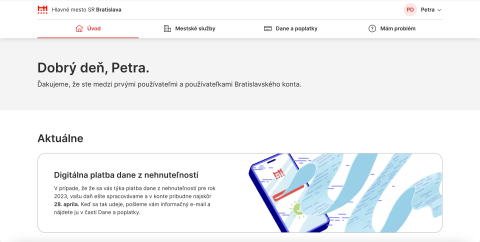Bratislava ID - Bratislavske konto - Bratislava
Bratislava (Slovakia)
Over the past 4 years, the Department of Innovation and Digital Services implemented service design principles when introducing and digitasing city services. The team has started transformation of key services in collaboration with Bloomberg Philanthropies and UK gov innovation agency FutureGov. Our goal was to move away from digitising paper to creating a new process around digital.
Our mantra is to start small, but think big. We are launching and testing one service at the time to see the impact and react to user feedback. The team has mapped the needs of our colleagues as well as various residents' groups. We have used design thinking principles along the way, we have tested the problem, co created solutions, validated them with residents’ groups depending on the service.
Key principles are transparency, open source, co-creation and continuous improvement.
Bratislava ID (Bratislavske konto) - https://bratislava.sk/konto came up in testing with various groups as a desired place, an umbrella platform for all city services regardless of their provider. It was designed with users in mind and reflects their feedback via HotJar, Plausible analytics, front-office contact with residents or feedback forms. Their feedback is evaluated with the goal of continuous improvement of the service.
Our strategic vision has been codified in the city-wide strategy Bratislava 2030 as well as the domain Innovation strategy - https://cdn-api.bratislava.sk/strapi-homepage/upload/Inovacie_koncepcia_ENG_f5c8f1d0bf.pdf
Services available in the first phase are: Digital Property Tax Payment, Swimming Pool Online Tickets, Zoning and Building Permits as well as links to all city and city organisations services.
We have taken special care in testing with senior or disabled groups to make sure the service is accessible based on legal guidelines as well as user preferences. Language is an important part of the process, it is often simplified and humanised, but still staying professional. We have internal guidelines on how we write our copy and have a dedicated copywriter checking every text.
We are using a simple design system based on proven design systems (UK Gov, Spotify, Google) with personal touches of the city through illustrations and icons.
All our services are mobile first, which removes the barrier for having access to a desktop computer. City also provides help with onboarding in our front office either in person or online.
We also offer simple sign up tools, since the national eID is only used by 12,6% of city residents, users can choose to create an account or use some of the services anonymously.
Since its launch on 4 April 2023, it has attracted over 20 000 residents of the city within 2 weeks.
Internal impact with each transformed service streamlines cooperation across departments, creates clear flows of submitted residents’ forms and provides information about how long and who is taking care of their request. This allows the city to measure effectiveness of the city hall, set KPIs and clearly identify issues in processes that were unclear by now.
With different services requiring official communication with residents, there is also a faster, more reliable and cheaper way to communicate. For example one postal envelope costs the city 3,14 EUR, and there are 500 000 residents.
For residents, they receive clear guidelines before, during and after submitting their request.
During the preparation phase, we have engaged at least 100 of our colleagues, we have had 4 show and tell internal sessions inviting our colleagues to join us in testing and report on progress. We have also tested with at least 100 different residents from multiple user groups - students, working professionals, seniors.
